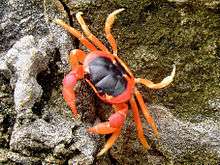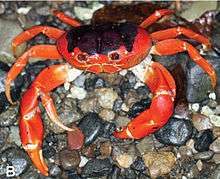Gecarcinus
Gecarcinus is the type genus of the land crab family Gecarcinidae. They are found in warmer coastal regions of the Americas, including islands in the Caribbean. Four species from oceanic islands were formerly included in Gecarcinus as the subgenus Johngarthia, but are now treated as a separate genus, Johngarthia.[1] While all members of this genus are largely terrestrial, they have to return to the ocean to breed (the larvae are released into the sea). They are often colourful, with reddish, orange, purple, yellowish, whitish or blackish being the dominating hues. This has resulted in some species, notably G. quadratus and G. lateralis, gaining a level of popularity in the pet-trade.
| Gecarcinus | |
|---|---|
.jpg) | |
| Gecarcinus quadratus | |
| Scientific classification | |
| Kingdom: | |
| Phylum: | |
| Subphylum: | |
| Class: | |
| Order: | |
| Infraorder: | |
| Family: | |
| Genus: | Gecarcinus Leach, 1814 |
| Type species | |
| Cancer ruricola | |
Species
| Image | Name | Common name | Distribution |
|---|---|---|---|
 | Gecarcinus lateralis (Fréminville, 1835) | blackback land crab, Bermuda land crab, red land crab | South Padre Island, Texas south to Macuto, Venezuela |
 | Gecarcinus quadratus (Saussure, 1853) | red land crab, whitespot crab, halloween crab, moon crab, halloween moon crab, mouthless crab or harlequin land crab | Pacific coast from Mexico south to Panama |
 | Gecarcinus ruricola (Linnaeus, 1758) | purple land crab, black land crab, red land crab, and zombie crab | Cuba and the Bahamas in the west through the Antilles to Barbados in the eas |
 | Gecarcinus nobilii Perger & Wall 2014 | South American Pacific coast, from Colombia to Peru | |
gollark: Okay, just come here and try it.
gollark: On your neural interface, I mean?
gollark: Anyway, perhaps you would like to... *test* a potatOS computer?
gollark: You said `or even a cc emulator in cc`, please stop being hypocritical.
gollark: jrengen: look at discord, you can see that bit of code the potatOS sandbox has for, OH LOOK, running the BIOS inside a filesystem sandboxing.
References
- Peter K. L. Ng, Danièle Guinot & Peter J. F. Davie (2008). "Systema Brachyurorum: Part I. An annotated checklist of extant Brachyuran crabs of the world" (PDF). Raffles Bulletin of Zoology. 17: 1–286. Archived from the original (PDF) on 2011-06-06.
Further reading
- Bright, D., & C. Hogue. 1972. A synopsis of burrowing land crabs of the World and list of their arthropod symbionts and burrow associates. Contributions in Science. No. 220. Available online (PDF)
- Ng, P., & D. Guinot, 2001. On the land crabs of the genus Discoplax A. Milne Edwards, 1867 (Crustacea: Decapoda: Brachyura: Gecarcinidae), with description of a new cavernicolous species from the Philippines. Raffles Bull. Zool. 49: 311-338.
- Türkay, M. 1970. Die Gercarcinidae Amerikas. Mit einem Anhang uber Ucides Rathbun (Crustacea: Decapoda). Senckenberg. biol. 51: 333-354.
- Türkay, M. 1987. Landkrabben. Natur Mus. 117: 143-150.
- Perger, R., & A. Wall. 2014 The description of a new species of the Neotropical land crab genus Gecarcinus Leach, 1814 (Crustacea, Decapoda, Brachyura, Gecarcinidae). ZooKeys 435: 93–109. doi: 10.3897/zookeys.435.7271
External links


This article is issued from Wikipedia. The text is licensed under Creative Commons - Attribution - Sharealike. Additional terms may apply for the media files.